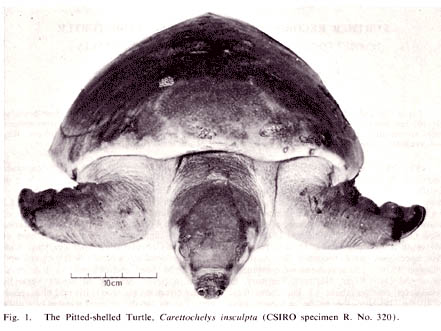

Further records of the Pitted-shell Turtle (Carettochelys insculpta) from Australia. Transactions of the Royal Society of South Australia. 96(2):115-117.
R. SCHODDE,* I. MASON,* and T. O. WOLFE*
* Division of Wildlife Research, CSIRO, P.O. Box 84, Lyneham, A.C.T., 2602, Australia
Summary Further records of the Pitted-shelled
Turtle, Carettochelys insculpta, including the first breeding
record, are reported from northern Australia. It is concluded that
the species occurs in river systems right around the landward margins
of the Sahul Shelf. The stone fruits of Pandanus, whenever
they are available, appear to comprise an important item of the turtle's
diet. |
A second verified record now comes from the South Alligator River system, approximately 400 km east of the Daly River site. There, in Yellow Waters billabong on Jim Jim Creek, a single female (CSIRO R. No. 320) was caught by a CSIRO fauna survey team on 5 November 1971. the specimen (Fig. 1), deposited in the museum of CSIRO's Division of Wildlife Research, Canberra, is large, having a carapace length of 45.6 cm. This compares with ca 48-50.5 cm for the largest New Guinea specimens (Walther 1922; Schultze-Westrum 1963). Other dimensions, taken from life, are: carapace breadth (including marginals) 36.5 cm; total height (carapace + plastron) 14.8 cm; head length (to base of crown) 15 cm; head width 8.1 cm; head + neck length (to gular shields of plastron) 18.5 cm; fore-limb length (posterior margin of the flipper) 26.4 cm; hind-limb length (anterior margin of the flipper) 25.3 cm; tail (to base of anal shields of plastron) 16.9 cm long, with 12 or 13 dorsal scute bands. Soft part colours: shell, limbs, head and tail, mid to dark olive-brown dorsally, grading to cream ventrally (fleshy scream on plastron); iris mid blue-green-grey. Except for the reduced number of caudal scutes, quoted at 14-16 for New Guinean specimens by de Rooij (1915), the South Alligator specimen appears to be identical with New Guinean forms. |

Fig 1. The Pitted-shelled Turtle, Carettochelys insculpta (CSIRO specimen R. No. 320). |
The condition of the
reproductive tracts showed the female to be in the process of laying;
a large number of enlarged magalecithal ova were present in the ovaries
(Fig. 2). Many follicles also appeared to have ruptured recently,
and both oviducts were markedly swollen. The large unshed ova were
almost the size of shelled eggs according to the dimensions for the
latter illustrated by de Rooij (1915, fig. 102). Because Yellow Waters
billabong, ca 30 km up stream above tidal influence on the
South Alligator system, had been landlocked between April and November
during the monsoonal dry season, there can be no doubt that eggs had
been deposited somewhere along the billabong. This represents the
first evidence that the species breeds in Australia. |
1 Known locally in the Northern Territory by the appropriate vernacular of “pig-nosed turtle” (J. Cann, pers. comm.).
Navigation: Page 1 Page2 |